I've ranted a few times about the many reasons I dislike the use of steamers on tailored clothing, but one of the reasons which I failed to fully explain was ironwork. Tailors use heat and steam to transform a flat piece of cloth into a 3-dimensional shape, only some of which occurs due to seams and darts, the rest is worked up with the iron (thus, ironwork).
Here's a look at what goes into the jacket before a single stitch is sewn; the trousers get worked up as well, which I alluded to in a previous post somewhere. The pages are nicked from an old textbook entitled (somewhat pompously) Il Sarto Architetto (The Tailor as Architect) and those who can't read Italian will still be able to get an idea of what's going on here. Namely, that a lot of shaping is being done which can be ruined with the aid of a jiffy steamer. You wouldn't notice anything jumping out at you, but the garment just wouldn't have the same shape or fit as before; very fitted or shapely (men's) garments are impossible to achieve without a good deal of this ironwork- something looser or more boxy will have less of it.
Cross-hatch lines indicate stretching and curved lines indicate shrinking.
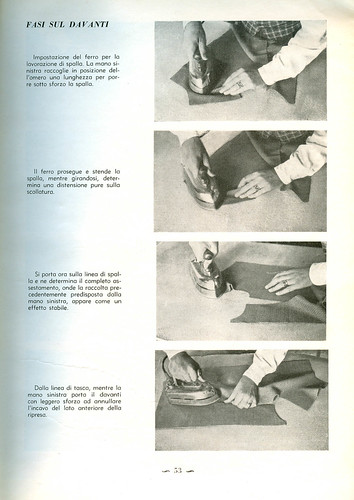


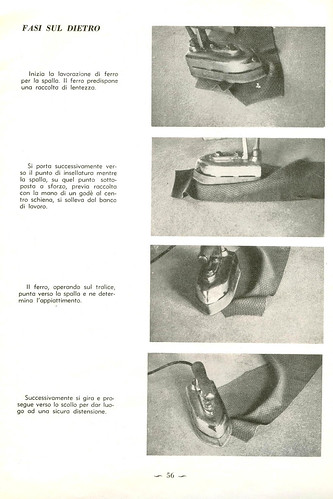
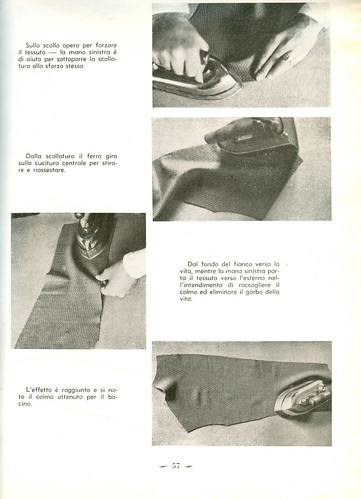


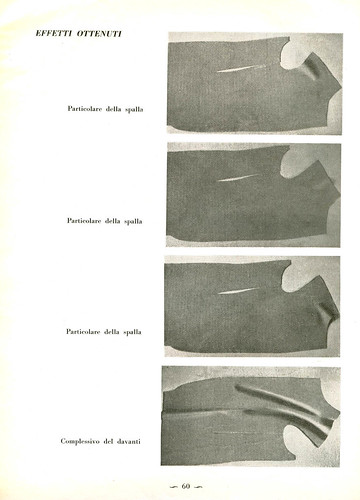
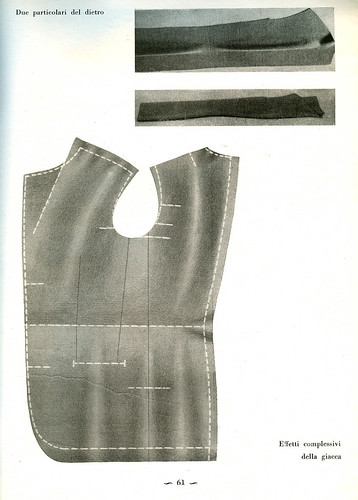








24 comments:
Good job Jeffery, an informed client is a better client.
thank you for a very helpful post.
a.
www.littlethistles.blogspot.com
Thank you ever so much for this. I was looking for an Italian ironwork instruction!
thank you for taking the time to put these pages up.. i've always wondered how they achieve shape in rtw though, obviously it's not the same as a tailored garment, but do they bother with ironwork at all, or solely rely on darts and cut for shaping?
This is so interesting. Something you would not think of before hearing it from a tailor. How can you reintroduce this kind of shaping after wearing it, or dry cleaning? Does it more or less hold after it gets sewn together?
I inquired with my tailor on how much of the shape of the suits he makes are due to seams and how much is due to ironwork. He seemed surprised I brought it up and said that about 12 to 15% is due to shaping with an iron.
Can you potentially screw up a well cut pattern with bad ironwork? Like throw off the shoulder point and misshape the armhole?
What is that underarm dart called in the last picture between the front dart and side seam? What is its purpose?
@s. All RTW garments have at least a bit of ironwork to them, though it is integrated in the construction sequence. For example, I prefer to stretch the inseam of the top sleeve before joining it to the undersleeve so I know the curve is just right. In a factory, the undersleeve is cut about 1/4" longer than the top- the two are joined at the inseam and then pressed open on a shaped buck so the presser can also stretch the topsleeve at the same time. Different levels of garment will have different amounts of shaping (why some RTW can look better than others).
@Christopher- wool is used because it holds a shape fairly well but it doesn need to be maintained. Light touch-ups can be done at home with an iron and press-cloth. After dry-cleaning, it's best to find someone who really knows how to press. Rave FabriCare is one, I am sure there are others.
@Anonymous- Yes, you can absolutely screw up a garment with bad ironwork. It is one of those secret black arts which must be learned at the hands of a master :) Which is why you rarely see it in print- you really can't learn it from a book.
@Anonymous- It's just called an underarm dart and gives some shape to the waist. These days most people use a separate side body (the dart becomes a seam) because you can get better shape with less distortion under the arm (and less ironwork).
And when you do see it in print, the diagrams are more helpful than the accompanying text.
I would absolutely love to see a video of someone doing proper ironwork on a jacket. The motions of the iron are pretty important, I would imagine.
Oh! I'm also wondering too if when you mean a steamer you're talking about one of those things that look like a vacuum cleaner hooked up to a boiler, or an iron that can release steam on a trigger as well but can also be used as a dry iron? I bought myself an Ace-Hi at the behest of a local tailor in the area and it seems to be working like a charm for me.
Hi Jeff, great post again....ironwork is still something which still alludes me, I cant seem to find any videos that show this in action on a jacket. Would second a request for a short video showing how to strecth and shrink parts of a jacket! Would be a fantastic help for amateur sewers like myself! Cheers
Jeffery, how about a short-list of your preferred dry irons for pressing clothes properly and sources where they can be bought. You might include some lightweight irons as well as mediumweight choices and their heavyweight counterparts.
JMB
If any of the various diagrams around on iron work don't help, I'm afraid a video will not be much more of a help either. I say if you are on good terms with a tailor cut out some fabric and see if he will take the time (with a little monetary contribution on your end) to show a quick a dirty method for these operations. This is truly an operation that needs one on one tuition. Other wise buy lots and lots of cloth and just get stuck in until you start to see the results in the diagrams.
@ Mr. Ratspeed- sure you need help? I mean you're a big time tailor now with your new company and all :D
@JM: Well, when I was working on my frock, I took it to the only tailor in town who had any knowledge in custom coatmaking. His experience was limited mainly to clerical cassocks from 30 years past when he lived in Chile. He wasn't familiar with ironwork and looked at me funny when I asked about it. He insisted that ironwork just wasn't done. Rather, he suggested the way to shrink areas was to make small gathering into the seam allowance in the areas needed. I was grateful for the advice so I listened. After my meeting with him, I confirmed with someone else from C&T that yes, gathering is another method that can be used to shrink rather than actual heat shrinking, and that I should listen to the advice the man had to offer. So, what I did was take the local tailor's method of gathering, then added steam at the edge to remove the fullness. It seems to have worked. But this method has its limitations. It wouldn't work in areas that call for shrinking the middle of the cloth. So, that tells me there HAS to be a way to shrink without gathering.
I don't agree that a video wouldn't help. Perhaps it's not as good as being there in person and having hands-on instruction, but seeing someone with professional knowledge zipping through the process where you know that he's doing it "right" makes all the difference in the world. For instance, this video here: http://www.youtube.com/watch?v=6qKOfKHrUgo made all the difference in the world to me when I saw it. It's good to know what the finished puzzle looks like before mapping out the pieces and putting them together. English helps, too. :)
As for the comment directed solely toward me, let's try to be respectful while posting on someone else's blog, ok?
Huh, I posted a comment but it disappeared. I guess Blogger messed up.
The jist of it was, yes, I took my garment to a tailor and he said shrinking was wrong, gathering was right. A C&T tailor confirmed that gathering was another method acceptable. I tried it, used steam to remove the fullness and it seemed to work, but wouldn't be helpful in the mid-cloth garment sections if needed.
Videos would help, just as this one helped me: http://www.youtube.com/watch?v=6qKOfKHrUgo
Boys, behave.
Have to say no to the video for several reasons.
1- Ironwork is draft and figure specific so you don't do the same thing all the time.
2- Learning it from a video would be like learning to play piano by watching a video. You need someone experienced standing next to you, guiding you, and correcting you. Which is why I also disagree with just buying some cloth and plodding away.
3- It's just waaaaaay too much work to produce a video like that.
@Benedict- for home use, a steam iron works fine. As to which one, Consumer Reports is probably a better source of advice.
@RR- yes, gathering does work, but you still need to shrink it out. It also assumes you know how the cloth will react to the fullness. But there is also the element of stretching certain parts. So when you do the shrinking and stretching first, you can put your piece flat and see the shape and evaluate whether it is correct or not. With gathering, it's just a guess.
Thanks :)
sorry forgot the :P
The Reverend knows I like to pick, at least I hope so.
You're right perhaps just pluggin away would be an exercise in futility with out at least a fundamental understanding of the process.
hi Jeff, how long would you say a forepart takes to shape with an iron on average? Thanks!
@brendan- depends on what you have to do to it, but it's not very long if you have a vaccuum table. If you have to wait for your parts to dry, then it takes longer. The back gets more shaping than the front.
J
Jeffrey, I thought I knew a thing or two about tailoring, ironing, etc. - but this post is amazing. It's going to take me a few reads to absorb everything here - and I think you convinced me I need a better (wider) ironing board. Truly an art.
Hi'
I'm glad I saw this blog because I have the same opinion about steamers.
Order Wallex Dry Iron online today and keep your wardrobe looking sharp! Available online at affordable prices, you can shop from the comfort of your home and have it delivered right to your doorstep. Whether you're ironing cotton, silk, or synthetics, Wallex has the power and precision to handle it all. Choose Wallex Dry Iron for hassle-free ironing and a polished look every time.
Post a Comment